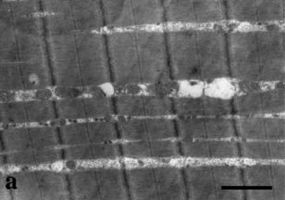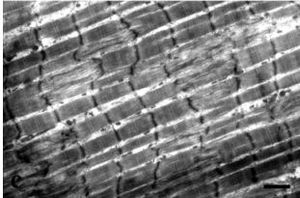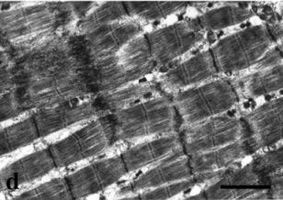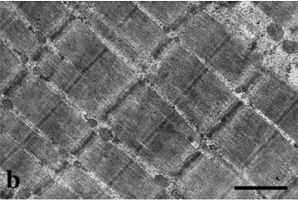Delayed Onset Muscle Soreness
Delayed Onset Muscle Soreness (DOMS) is a familiar experience to most people who exercise. It effects people who weight train and run particularly, and DOMS can produce anything from mild muscle soreness to debilitating pain and weakness.
Contents
1 What is DOMS?
DOMS generally occurs between 24 and 72 hours after unusual or severe exercise, such as racing a marathon. DOMS is particularly related to eccentric exercise, which is where the muscle works to resist becoming longer, rather than working to contract. When you muscles absorb the impact of running, this is eccentric. Downhill Running is much more eccentric than flat or uphill running.
- Muscle damage from eccentric exercise (downhill running)
Muscle before downhill running[1]
Immediately after downhill running[1]. Notice the disruption to the dark bands (z-bands) that are part of the muscle structure showing there is immediate damage.
One day later[1], the damage and disruption is worse, indicated some continued breakdown.
Muscle 14 days later[1], structurally recovered (other metrics do not return to pre-exercise levels at 14 days).
2 What are the symptoms of DOMS?
The soreness of DOMS is different to a 'pulled' muscle. With DOMS, large areas of the muscle are very tender to the touch, and the pain is very unpleasant. With a pulled muscle, the area of tenderness is usually more localized and the pain of massage is sometimes described as a 'good pain'. The pain of DOMS will normally lessen with light exercise such as walking. This is often described as 'loosening' up.
3 Why is DOMS important?
DOMS can prevent continued running, due to weakness and soreness. However, the biggest issue for long distance runners is that although the pain occurs 24-72 hours after exercise, the weakness peaks after 30 minutes [2]. If you've ever run a long, steep decent (the latter part of Iron Mountain or Mount Mitchell Challenge spring to mind), you'll know the strange feeling of weak numbness that pervades your quads as the effect of the downhill builds up. If you've felt a similar weakness in the latter stages of a marathon, this may not be Glycogen depletion creating 'the wall', but eccentric muscle damage that will later manifest itself as DOMS. It is suggested that this is the reason the Boston Marathon course is relatively slow, even though it is a net decent.
4 What does DOMS mean to you?
There is some good news in all of this. While excessive eccentric exercise can cause DOMS, doing some eccentric exercise causes the muscles to adapt and to be able to handle eccentric exercise without DOMS [3]. There are two ways then of protecting your muscles from DOMS in running; running greater distances, or running downhill. It is downhill running that is greatly underutilized in training regimes. Most hill training workouts focus on the uphill segment, and relegate the downhill to recovery. While uphill can produce some benefits, it is the downhill that can provide the greatest advantage. Adding hills into your workout can make you a much stronger runner, and have benefits even on flat race courses. Don't just use the downhill to recover from the uphill, but work on the downhill.
5 How to treat DOMS?
Do if you do get DOMS, what can you do?
- Some[4], but not all[5] studies show that Graduated Compression Clothing mitigates DOMS.
- Caffeine has shown to be effective in reducing the pain of DOMS, as well as reducing the weakness[6].
- NSAIDS (Ibuprofen, Acetaminophen/Paracetamol, etc.) have been shown to increase the pain of DOMS, though they may delay its onset[7], and NSAIDS may also impair healing[8].
- The evidence for anti-oxidants is scant, but Vitamin C, D and E might help.
- The evidenced for massage, stretching and ice is ambiguous[9]. In fact, short periods of icing can make DOMS worse[10].
- Light exercise has been shown to relieve DOMS[11].
- Performing a Warmup before exercise does not appear to reduce the resulting DOMS[12].
My personal experience is that a small amount of easy running, while painful, can speed up recovery. I have found no benefit to ice, massage, or Ibuprofen.
6 Tangent - DOMS and Lactic acid
DOMS is not caused by lactic acid; a full discussion will have to wait until I write an entry on 'the lactic acid myth', but suffice to say, lactic acid is your friend, not your enemy.
7 See Also
8 References
- ↑ 1.0 1.1 1.2 1.3 Neuromuscular disease-associated proteins and eccentric exercise http://jp.physoc.org/content/543/1/297.full.pdf
- ↑ Comparison of the symptoms of exercise-induced muscle damage after an initial and repeated bout of plyometric exercise in men and boys http://jap.physiology.org/cgi/content/full/99/3/1174
- ↑ Skeletal muscle damage and repair http://books.google.com/books?id=ueMh1x7kFjsC&lpg=PA195&ots=wwIhuoi0Nt&dq=Tiidus%201997&pg=PA69#v=onepage&q=Tiidus%201997&f=true
- ↑ Continuous Compression as an Effective Therapeutic Intervention in Treating Eccentric-Exercise-Induced Muscle Soreness http://journals.humankinetics.com/jsr-back-issues/jsrvolume10issue1february/continuouscompressionasaneffectivetherapeuticinterventionintreatingeccentricexerciseinducedmusclesoreness
- ↑ Viguier, M.; Richette, P.; Bachelez, H.; Wendling, D.; Aubin, F. (Jan 2010). "[Paradoxical cutaneous manifestations during anti-TNF-alpha therapy].". Ann Dermatol Venereol 137 (1): 64-71; quiz 63, 78-9. Template:citation/identifier. Template:citation/identifier.
- ↑ Caffeine Attenuates Delayed-Onset Muscle Pain and Force Loss Following Eccentric Exercise http://www.nowfoods.com/idc/groups/public/documents/digital_asset/074390.pdf
- ↑ B-Com Web https://b-com.mci-group.com/Abstract/Statistics/AbstractStatisticsViewPage.aspx?AbstractID=107621
- ↑ Ultrarunning magazine, May/June 2010, "Dealing with DOMS"
- ↑ Delayed onset muscle soreness exercises http://www.sportsinjurybulletin.com/archive/1077-muscle-soreness.htm
- ↑ Template:cite journal
- ↑ Manual massage and recovery of muscle function following exercise: a literature review http://www.ncbi.nlm.nih.gov/pubmed/9007768
- ↑ Evans, RK.; Knight, KL.; Draper, DO.; Parcell, AC. (Dec 2002). "Effects of warm-up before eccentric exercise on indirect markers of muscle damage.". Med Sci Sports Exerc 34 (12): 1892-9. Template:citation/identifier. Template:citation/identifier.



